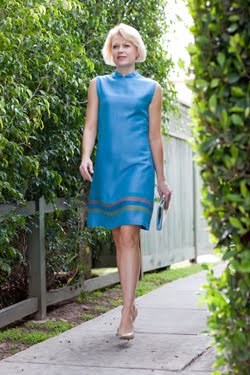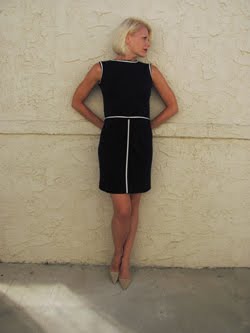Mention the words German Expressionism and you just might put a panic into even the most ardent of classic cinema fans. It's that seemingly scary combination--it's foreign and it's silent. But honestly...when you take the time to watch one, none of that matters. German Expressionism of the 1920s is renowned for its moody ambience and highly influential style....stunning visuals that would go on to inspire the best of film noir. One of my favorite examples--and one of The Style Essentials on GlamAmor for its lasting impact on fashion--is Louise Brooks in G. W. Pabst's 1929 classic Pandora's Box.
Pabst is a legend of early cinema. The composition of his shots was elegant and ahead of its time, especially when combined with the lighting of cinematographer Gunther Krampf. Together they used shadows to create drama and, especially toward the end of Pandora's Box, a somewhat sinister mood. Some scenes in the movie included filtering light through window blinds, which would later become a staple of film noir style. In the 1930s, directors like Josef von Sternberg continued to refine the look; his cinematography with Lee Garmes and James Wong Howe for 1932's Shanghai Express, for example, shows even more of the evolution. And when film noir hit its stride in the 1940s, directors Billy Wilder (Double Indemnity), Carol Reed (The Third Man), Michael Curtiz (Mildred Pierce), and Alfred Hitchcock (Notorious) all admitted their admiration for Pabst and Pandora's Box. "There's no question," says Film Noir Foundation founder Eddie Muller, "that German Expressionism was one of the strongest roots from which film noir grew."
Pabst was a visionary when it came to actors, too...recognizing something very modern about his star and muse Louise Brooks. In the days of silent cinema, acting was often exaggerated in order to compensate for not speaking. Louise, in contrast, did not do anything of the sort. In fact, she seemed to be doing nothing at all. But we can now see that she was doing everything...with her eyes, her face, her body. Her passion gave her an energy and immediacy on screen. Even the great Marlene Dietrich paled in comparison in Pabst's eyes...keeping her only as back up if Paramount failed on its promise to loan out Louise. "Brooks had both innocence and the ability to project sexuality without coyness or premeditation," he said. And for the character of Lulu, this magical combination was essential.
Lulu could be considered an early precursor to the femme fatale--after all, those who loved her suffered and even died because of it. She also finds a tragic fate of her own. But unlike, say, Kathie Moffat from 1947's Out of the Past, Lulu never really seems motivated by ill intentions. Instead, she is a free spirit who is both sensual and sexual and simply longs to love and love again. Interestingly, this was very much the case with Louise offscreen as well...known for love affairs with men and women alike, including a one night stand with Greta Garbo. Even for the 1920s, both film and star pushed boundaries and tested our societal mores. In the end, the frank portrayal of sexuality in Pandora's Box would soon be outlawed by Hollywood in 1930 with the start of the Hays Code.
Lending to Lulu's seduction are the all-important costumes of Pandora's Box. Though the wardrobe was overseen by (and credited to) Art Director Gottleib Hesch, Louise's clothes were courtesy of Jean Patou. Patou is one of the legendary European couturiers of the early 20th century, already dressing Louise and other international stars such as Gloria Swanson both onscreen and off. Along with Coco Chanel, he is considered the inventor of our modern casual attire, especially in the area of sportswear. Patou brought knits into fashion--from swimwear to some of the first cardigan sweaters. But he was also a wiz when it came to glamour. His inclination toward more and more of a streamlined silhouette made him partially responsible--along with costume designers like Travis Banton--for how Art Deco design transitioned from the 1920s to the 1930s.
Pandora's Box is one of The Style Essentials for its impact on fashion both then and now. The Louise Brooks bob alone is iconic. The second it was seen onscreen, everyone began to bob their hair. This even included Hollywood heavyweights Mary Pickford and Clara Bow, who was already celebrated for her own style. Of course the cut is still popular today...seen on actresses like Katie Holmes and supermodels like Linda Evangelista. Other fashion trends that stem from the movie include Patou's tank dress, which became a staple of 1930s style and resurged in popularity once again in the 1990s. Pandora's Box fan Calvin Klein included them in collection after collection that decade. And Prada is still remembered for dressing Uma Thurman in one for the 1995 Academy Awards. At this year's Oscars, we saw another 20s-30s trend with jewelry draped down the back of some stars, which brought to mind Patou's bejeweled razor back dress for Lulu (above).
If the idea of German Expressionism once seemed completely foreign to you, let Pandora's Box show you how influential and relevant it really is. From some of the visual origins of my beloved film noir to the ongoing inspiration in fashion from Jean Patou and Louise Brooks, there is so much to admire about it. Don't just take my word for it...look inside Pandora's Box for yourself.
Louise Brooks plays Lulu, a girl whose free spirit brings trouble to those who love her...
we meet her in this dress that would inspire others like Edith Head for Rear Window
Lulu is mistress to newspaper publisher Dr. Ludwig Schon
who is engaged to be married but cannot resist her
Lulu meets up with best friend Alwa--who also happens to be Schon's son--
Lulu stars in Alwa's revue, but refuses to perform when Schon Sr. brings his bride-to-be
The upper part of her stage costume--both front and back--are influential on modern designers,
highlighted by some incredible cinematography
Schon tries to force Lulu to get on stage, but he is seduced instead
Caught in the act...
look how modern Louise looks in this shot
Schon decides he must marry Lulu...
her wedding dress is a perfect bridge between the style of the 1920s and that of the 1930s
Everyone seems to love Lulu, including the Countess Augusta Geschwitz ...
a groundbreaking subplot in this 1929 silent
Suddenly Alwa becomes desperate for Lulu's love as well
and that only pits father against son
and that only pits father against son
The 1920s and 1930s were known for their dresses with dramatic backs such as this
Schon begs Lulu to kill herself,
but she ends up accidentally killing him instead
Lulu stylishly plans her escape
Alwa cannot let go of his love and offers to help Lulu
using Countess Augusta's passport
While on the train, news of Lulu's escape and bounty hits the papers
Even on the run, Lulu never loses her spirit...
great shots of the iconic Louise Brooks bob
In order to survive, Alwa resorts to gambling in underground casinos
This type of tank dress became enormously popular in the 1990s,
including by Calvin Klein and Prada
Alwa gambles the couple into trouble and
Lulu considers offering herself to the owner of an Egyptian brothel to save them
On the run again...this time in stripes and sailor pants a la Chanel
More incredible and inspiring cinematography from Gunther Krampf
when Lulu ends up in London with Alwa
when Lulu ends up in London with Alwa
Lulu comes to the decision she must walk the streets for them to survive, even in squalor
Her first client turns out to be Jack the Ripper
Even though he likes her, Jack cannot control his murderous impulses...
Lulu's fate is sealed with a kiss
This article is included in this month's Fashion in Film blogathon--
take a peek at The Hollywood Revue for even more!














































































































































